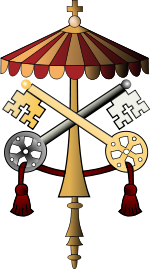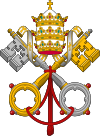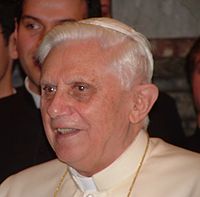- Papal conclave, 2005
-
Papal conclave, April 2005 
Dates 18–19 April 2005 Location Sistine Chapel, Apostolic Palace, Vatican City Dean Joseph Ratzinger Vice Dean Angelo Sodano Camerlengo Eduardo Martínez Somalo Protodeacon Jorge Medina Estévez Secretary Francesco Monterisi Ballots Pope elected after 4 ballots Elected Pope Joseph Ratzinger
(took name Benedict XVI)The Papal conclave of 2005 was convened as a result of the death of Pope John Paul II on 2 April 2005. After his death, the cardinals who were in Rome met and set a date for the beginning of the conclave to elect John Paul's successor. The conclave began on 18 April 2005 and ended on the following day after four ballots. Eligible members of the College of Cardinals of the Roman Catholic Church (those who were younger than 80 years of age at the time of the death of Pope John Paul II) met and elected Cardinal Joseph Ratzinger, Dean of the College of Cardinals as the new Pope. After accepting his election, he took the regnal name Benedict XVI.
The first ballot, on the evening of 18 April, produced black smoke from the chimney of the Sistine Chapel, meaning no pope had been elected. More black smoke followed the two morning ballots of 19 April. White smoke emerged in the afternoon but the fact that initially the bells of St. Peter's Basilica did not ring left some uncertainty as to what this meant. Shortly after 6 p.m, they did begin pealing, thus confirming that a new pope had been elected.
Contents
Papal election process for 2005
Main article: Papal electionPresiding over the conclave was the Dean of the College of Cardinals, Cardinal Ratzinger from Germany. Given that Ratzinger himself was elected Pope, the duty of asking if he would accept the election and what name he would adopt (duties normally performed by the Dean) fell, in accordance with the law,[clarification needed] to the vice-dean Angelo Sodano.
It fell to the Cardinal Protodeacon, Jorge Medina Estévez, to make the solemn announcement of the election of Cardinal Ratzinger as Pope Benedict XVI.
This was the first Papal election governed under provisions made by John Paul II in his Apostolic Constitution Universi Dominici Gregis, promulgated on 22 February 1996. According to tradition and declaration of the Camerlengo, Eduardo Martínez Somalo, Benedict XVI is the 265th Bishop of Rome, head of both the Latin Catholic Church and the Eastern Catholic Churches.
In a break with recent tradition, Universi Dominici Gregis provided that the cardinals were not to be locked under key in the Sistine Chapel precincts throughout the conclave. Instead they were to be lodged within the confines of the Vatican City State at the Domus Sanctae Marthae when not in session, where they did not have access to newspapers, television, radio, the Internet, or telephones for the duration of the election process.
Proceedings on 18 April began with a morning Mass for the Election of the Roman Pontiff (Latin Pro Eligendo Romano Pontifice). In the afternoon the Cardinal electors assembled in the Hall of Blessings in St. Peter's Basilica and from there went in solemn procession to the Sistine Chapel, where, after the singing of the hymn Veni Creator Spiritus, each cardinal took the prescribed oath. After these and other formalities for the start of the Conclave had been observed, Archbishop Piero Marini, Papal Master of Ceremonies, gave the traditional command extra omnes (everybody out). The doors were then locked, and the actual Conclave began. In accordance with the law, one round of balloting was held on that evening. Thereafter balloting was to continue until a new Pope was elected, on a schedule of two ballots each morning and two each afternoon. The ballot slips were to be burned at noon and 7 p.m. Rome time (10:00 and 17:00 UTC) each day. The traditional procedure is that smoke from this, in times past reinforced by adding handfuls of dry or damp straw, emerged from a temporary chimney on the chapel roof as for a conclusive vote (white smoke) or an as yet undecided one (black smoke). Nowadays the straw is replaced by chemically-produced smoke.
On 24 April, 5 days after Benedict XVI's election, he was ceremonially installed. Since Pope John Paul I, the historical Papal Coronation has been replaced by a simple investiture with the pallium and Papal Inauguration Mass. Many dignitaries of various countries, some of whom had attended the funeral of Pope John Paul II, also attended this function.
The cardinal electors
- For a full list, see cardinal electors in Papal conclave, 2005. For a list of those deemed likely to be elected see List of papabili in the 2005 papal conclave.
Papal Conclave of 2005 Electors 117 total Absent 2
*Jaime Sin, (Manila),
*Adolfo Suárez Rivera, (Monterrey)Present 115 Africa 11 Asia & Middle East 11 Europe 58 Oceania 2 Americas 35 DECEASED POPE John Paul II (Karol Wojtyła) NEW POPE Benedict XVI (Joseph Ratzinger) Although there were 183 cardinals in all, cardinals age 80 years or more at the time the papacy fell vacant were ineligible to vote in the conclave according to rules enacted by Pope Paul VI in 1971 and modified slightly in 1996 by John Paul II. Pope Paul also limited the number of cardinal electors to a maximum of 120, though John Paul sometimes disregarded this limit when elevating cardinals. At the time of John Paul's death, there were 117 cardinals under the age of 80 and therefore eligible to vote in the conclave. The late pope appointed another cardinal secretly (in pectore) in 2003, but his identity was never made public; since John Paul did not reveal the name of this cardinal before he died, the in pectore cardinalate expired on 2 April.
All the electors were appointed by Pope John Paul II, except Jaime Sin, William Wakefield Baum and Joseph Ratzinger. The result of this (with Cardinal Sin unable to attend) was that Cardinals Baum and Ratzinger were the only cardinals in the conclave with practical experience in the papal election process, having participated in the conclaves electing John Paul I and John Paul II. This state of affairs is not unparalleled in modern conclaves: the 1903 conclave had only one elector with previous experience in electing a pope, and the 1823 conclave only two. This was due to the long pontificates which immediately preceded such conclaves.
The cardinal electors came from slightly over fifty nations (up slightly from the 49 represented in 1978) around the world, about 30 of which have only a single representative. The Italian electors were the most numerous at 20, followed by the contingent from the United States of America with 11. It was officially announced on April 9 that two of the 117 cardinal electors, Jaime Sin of the Philippines and Adolfo Antonio Suárez Rivera of Mexico, would not be attending the conclave due to poor health, though some reports had said Cardinal Sin had hoped for medical clearance to travel. Sin died in June. Even two short of the full number, with 115 cardinals attending, this conclave saw the largest number of cardinals ever to elect a pope; both conclaves in 1978 had 111 electors present. The supporting votes of two-thirds of the cardinals attending a conclave are needed to elect a new pope in the initial phases of the process: in this case, 77 votes.
Course of balloting
Pre-balloting activities
The Holy See 
This article is part of the series:
Politics and government of
the Holy See- Benedict the Ass
- Conclave
Administrative Services- Status in international law
- At the United Nations
- Multilateral foreign policy
- Concordats
- Diplomatic missions
- Nuncios
On Saturday, 9 April, in Rome, 130 cardinals meeting in the "General Congregation" (including some non-voting cardinals) voted not to talk to the press until after the conclave.
The cardinal electors listened to two exhortations to the conclave cardinals before passing on to the first election on the afternoon of 18 April. The first of these exhortations on the state of the Church was delivered on the morning of Thursday, 14 April, in one of the daily general congregations. The preacher was Raniero Cantalamessa, a Capuchin friar and scholar in Church history, who has for several years preached the lenten sermons to the pope and his curial staff. The text of Cantalamessa's lecture was apparently leaked to the Italian press, who quoted him as having told the cardinals they "must guard against transforming Pentecost into a Babel, as happens when one looks for personal affirmation ... They ought to only search for the glory of God and the realisation of his reign." The second exhortation was delivered by Tomáš Špidlík in the Sistine Chapel after the extra omnes on the afternoon of Monday 18 April, and the closing off of the conclave area to outsiders.
First day
On 18 April, after concelebrated Mass in St. Peters, the cardinals proceeded to the Sistine Chapel while the Litany of Saints was chanted. After taking their places the "Veni Creator Spiritus" ("Come, Creator Spirit") was sung. At the first conclave since their restoration, Michelangelo's Last Judgement and ceiling appeared in their full glory. The occasion was very solemn. The Cardinal Dean of the Sacred College, Joseph Ratzinger, then read the oath:
-
- We, the cardinal electors present in this election of the Supreme Pontiff promise, vow and swear, as individuals and as a group, to observe faithfully and scrupulously the prescriptions contained in the Apostolic Constitution of the Supreme Pontiff John Paul II, Universi Dominici Gregis, published on 22 February 1996. We likewise promise, pledge and swear that whichever of us by divine disposition is elected Roman Pontiff will commit himself faithfully to carrying out the munus Petrinum of Pastor of the Universal Church and will not fail to affirm and defend strenuously the spiritual and temporal rights and the liberty of the Holy See. In a particular way, we promise and swear to observe with the greatest fidelity and with all persons, clerical or lay, secrecy regarding everything that in any way relates to the election of the Roman Pontiff and regarding what occurs in the place of the election, directly or indirectly related to the results of the voting; we promise and swear not to break this secret in any way, either during or after the election of the new Pontiff, unless explicit authorization is granted by the same Pontiff; and never to lend support or favor to any interference, opposition or any other form of intervention, whereby secular authorities of whatever order and degree or any group of people or individuals might wish to intervene in the election of the Roman Pontiff.
- Each cardinal elector affirmed the oath by placing his hands on the book of the Gospels saying aloud:
-
- And I, (name), do so promise, pledge and swear. So help me God and these Holy Gospels which I touch with my hand.
Cardinal Ratzinger, as Dean of the Sacred College, was first to go forward. He was followed by the Vice Dean, Angelo Sodano, and all the other cardinals in order of seniority.
Two cardinals were striking by their different attire in the sea of red and white: Cardinals Ignatius I Daoud of the Syrian Catholic Church and Lubomyr Husar of the Ukrainian Catholic Church. After Archbishop Piero Marini (the Papal Master of Ceremonies) intoned the words extra omnes (Latin, "everybody out!"), the members of the choir, security guards, and others left the chapel and the doors of the Sistine Chapel were closed, leaving the cardinals in conclave.
Results of the first ballot
On the first ballot, according to the Italian daily Il Messaggero, Carlo Maria Martini obtained 40 votes, Ratzinger obtained 38 votes, and Camillo Ruini a substantial number of votes, the rest of the votes being dispersed. Alternatively, an anonymous cardinal's diary suggested Cardinal Martini only received 9 votes during the first ballot and Ratzinger in fact received as many as 47.[1] Nonetheless, both totals fell short of the required threshold and Black Smoke (fumata nera) emerged from the top of the Sistine Chapel at around 20:00 Rome time. This signaled that the first ballot had been held and that no new pope had been elected.
Second day
The new pope Benedict XVI.
The morning session of the second day ended with the Sistine Chapel chimney emitting black smoke once again (even this time it was much lighter in the first few seconds; experts say this was because the stove was new and too clean), meaning that no new pope had been elected.
According to the Italian newspapers, Ratzinger had supposedly indeed reached or even exceeded the required 77 votes during the third ballot, but he asked for a vote of confirmation in the afternoon. If he had, it would have been consistent with the actions of John Paul I, who is said to have made the same request. However, according to some interpretations this would not be in conformity with the laws governing the conclave.
The cardinals left for lunch before returning for the afternoon session of balloting. Tens of thousands of people, waiting in St Peter's Square for the result, were quiet at the result and the reaction was very different from the first day.
At 15:50 UTC, white smoke rose above the Sistine Chapel followed by the pealing of bells ten minutes later. Pope Benedict XVI (Joseph Ratzinger) had been elected after four ballots. Indications given by the Italian press suggest that he obtained between 95 and 107 votes for this fourth and last ballot.
Things were not glitch free as the voting slips and notes were lit after that ballot. "All of a sudden, the whole Sistine Chapel was filled with smoke," Adrianus Johannes Simonis was quoted as saying by La Stampa and La Repubblica.
"Fortunately, there were no art historians present," joked Christoph Schönborn, in a reference to the priceless paintings and other treasures in the building.
The Apostolic Constitution promulgated by John Paul II, which governed the rules of the conclave, had mandated that the bells of St. Peter's were to ring following the election of a new pope. This was intended to avoid the confusion that ensued at the conclusion of the 1978 conclave when the color of the smoke was ambiguous following the successful election of John Paul II on the eighth ballot. However, the bells confirming the election of Benedict XVI began to ring only after a fourteen minute delay. Archbishop Renato Boccardo, the Vatican City Secretary-General, stated that there was a lack of coordination in the minutes following the election of the new pope. In the confusion, the Vatican official inside the conclave responsible for activating the bells failed to transfer the keys to the ringing mechanism to the appropriate person at St. Peter's Basilica in a timely fashion.
Vote counts from a "leaked" diary
On 23 September 2005 a text purporting to be the unauthorized diary of a cardinal was published by the Italian magazine Limes. The diary gave the impression that Ratzinger more or less scraped in, and that his chief rival in the election was not Martini, but rather Jorge Bergoglio of Buenos Aires. The story was covered by several agencies.
In reality the document little resembles a real diary and its credibility runs into other problems, not the least of which is that any notes taken in the voting sessions had to be handed over and burned after each ballot.[2]
Furthermore, the diary's detailing of Bergoglio's support was nothing new; prominent Catholic journalist John Allen discovered and reported on Bergoglio's candidacy—several months before the release in the alleged diary—in his book The Rise of Benedict XVI. Also, in the same book, Allen explained that, according to his interviews, Ratzinger's electoral victory was met with a large margin that had steadily gained momentum.
Many[who?] believe that the alleged diary was merely a re-hashing of already-known information, then sensationalistically trumpeted by the media as a breach in the Cardinals' oath of confidentiality.
See also
- Papabili
Notes
- ^ "Article based on diary says German cardinal became pope with 84 votes". Catholicnews.com. http://www.catholicnews.com/data/stories/cns/0505401.htm. Retrieved 2011-05-03.
- ^ "Catholic World News : Unknown cardinal breaks secrecy, describes conclave". Cwnews.com. 2005-09-23. http://www.cwnews.com/news/viewstory.cfm?recnum=39784. Retrieved 2011-05-03.
References
- Allen, John L., Jr. 2005. The Rise of Benedict XVI: The inside story of how the pope was elected and where it will take the Catholic Church. Doubleday Religion. ISBN 0385513208.
- Greeley, Andrew M. 2005. The Making of the Pope: 2005. Brown, Little. ISBN 0316861499.
- Weigel, George. 2005. God's Choice: Pope Benedict XVI and the Future of the Catholic Church. HarperCollins. ISBN 0066213312.
External links
- Vacancy of the Apostolic See (official website)
- Procedures and news
- Universi Dominici Gregis – the rules governing the election
- Conclave procedures (Time)
- Hacking the Papal Election, about the security of the election process
- Cardinal Ratzinger's homily to the pre-Papal Mass
- Punditry and predictions
- Article concerning Candidates for succession (Slate.com)
Papal conclave, 2005 Holy See elections Pre-1059 Before 105911th century 12th century 13th century 14th century 15th century 16th century 17th century 18th century 19th century 20th century 21st century 2005Categories:- Papal conclave, 2005
- Papal conclaves
- Pope Benedict XVI
- Pope John Paul II
Wikimedia Foundation. 2010.

